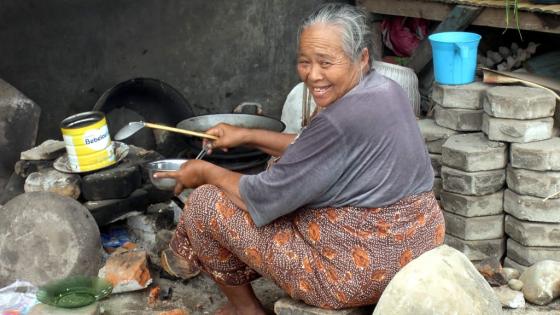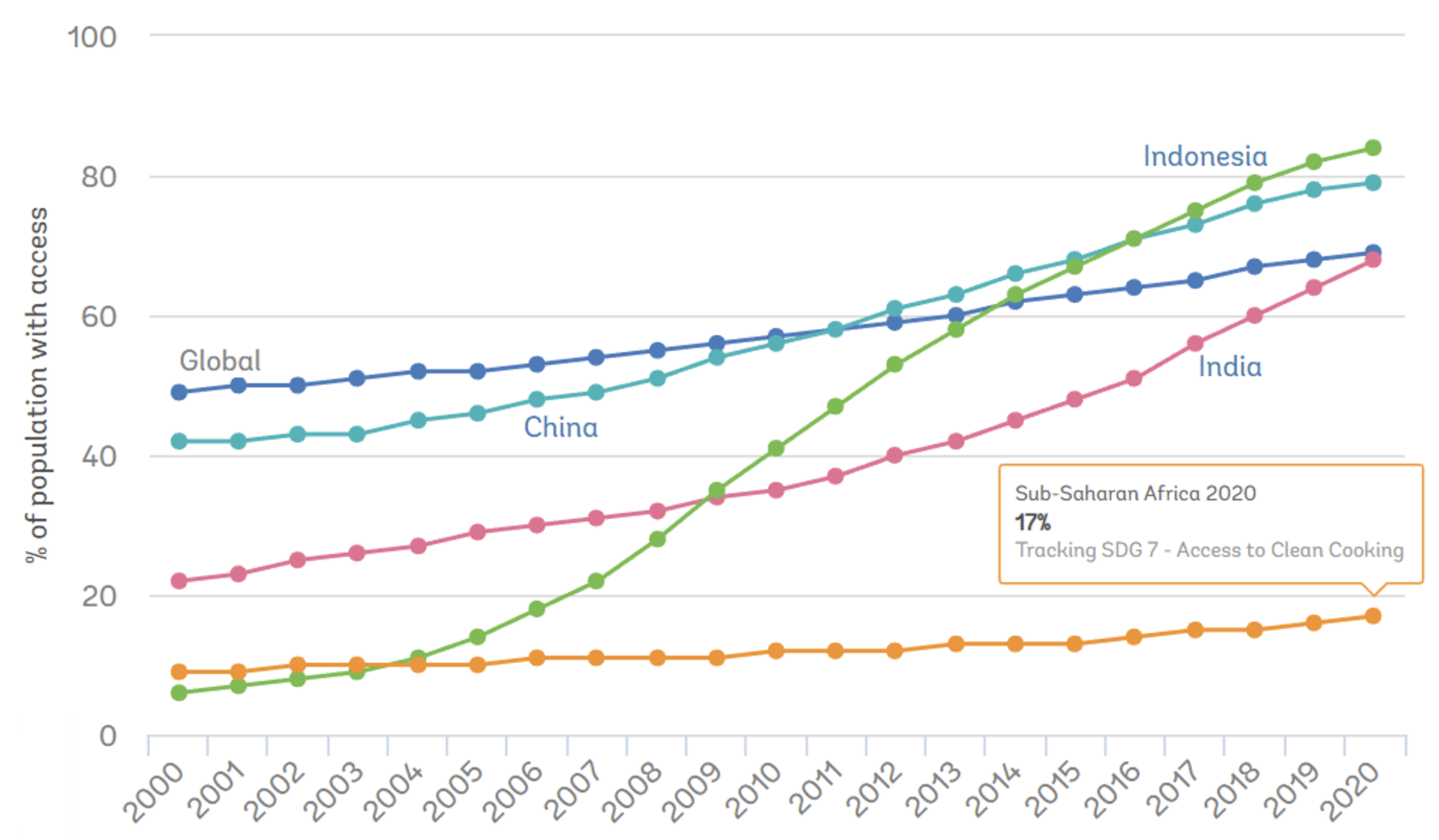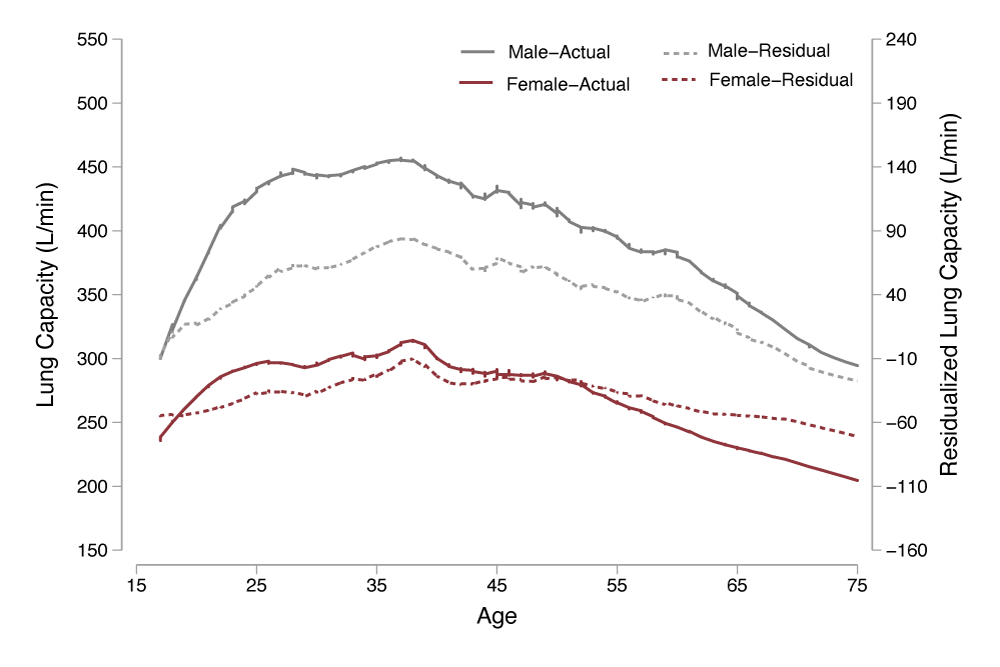Worldwide, about 1.2 billion people may lack access to electricity, but more than double this number (2.5 billion) lack access to modern cooking technology (IEA 2020). Burning dirty fuels produces dangerous pollutants, reaching 100 times the safe levels recommended by the World Health Organization (WHO). According to WHO estimates, indoor air pollution causes four million deaths annually, exceeding the death tolls of malaria, tuberculosis, and AIDS combined. According to the U.S. Energy Information Administration, nearly all of the growth in energy demand and its associated greenhouse gas emissions over the next three decades are forecasted to come from developing countries. Hence, understanding the drivers of clean energy transition in developing countries and its implications are central to implementing policies that will curb global emissions.
Figure 1 Slow progress on access to clean cooking, the UN’s 7th Sustainable Development Goal
Source: WHO Household Energy Database (2020), Geneva.
Policy instruments that can promote a sustained clean energy transition
It is often difficult to persuade people to switch to new and cleaner technologies. Many countries, such as China and India, have attempted to implement large fuel transition programmes. Existing studies point out that behaviours such as unwillingness to pay for clean fuels (Mobarak et al. 2012) and unfamiliarity with the proper use of clean technology (Hanna et al. 2016) can hinder household adoption of clean energy. However, these behaviours can be overcome using proper policy instruments, such as the instrument discussed here, and real impacts can be observed. Specifically, a clean cooking programme in Indonesia, which combines a subsidy on cleaner fuel with a restriction on dirty fuel, can lead to a high adoption rate and a sustained use of cleaner fuel if the combination prevents households from reverting to using dirty fuel (Imelda 2020). In less than ten years, Indonesia went from having a population with one of the lowest shares of access to clean cooking to having one of the highest shares in the developing regions of the world.
The obstacles to promoting a clean energy transition at home
There are at least two additional major obstacles in developing countries. First, though women are most susceptible to the adverse health outcomes of unclean energy, they may be unaware of its health consequences and thus unwilling to pay for clean energy. Figure 2 shows a large gap in lung capacity between men and women. Even after controlling for biological factors, the gap remains, suggesting the existence of a gender disparity in health. Second, even if women were aware of the benefits of clean cooking and preferred using clean energy, their choice often depends on men’s preferences because they have less bargaining power to make key household decisions. As a result, clean energy take-ups are always low, making it even harder to measure clean energy’s benefits.
Figure 2 Lung capacity by gender: observed capacity for men and women (solid lines); lung capacity residualised for age and height (dashed lines)
The relationship between clean energy, gender, health, and labour outcomes
In a new paper (Verma and Imelda 2022), we hypothesise that the lack of access to clean cooking imposes disproportionately higher health and productivity costs on women than on men. We also argue that the health burden associated with unclean cooking fuel can influence the labour supply of both genders. Clean energy access can indirectly increase men’s productivity through shifts in the intrahousehold division of labour whenever there is substitutability or complementarity between men’s and women’s labour inputs in both market work and household work.
Existing studies show a link between access to clean energy and female labour-force participation. But economic development presents confounding effects, and disentangling these effects is challenging because of the voluntary nature of cleaner cooking-technology adoption and confounding factors such as fewer labour opportunities for women (Utar and Keller 2020). Households that voluntarily adopt cleaner cooking technology tend to be in places with better infrastructure, so it is not clear from earlier studies how female labour-force participation depends on clean energy access.
We use a case study in Indonesia. Figure 1 shows a remarkable increase in the population share with access to clean energy, from 40% to 80% in only eight years. The reason for this increase is that the Indonesian government started a cooking fuel conversion programme in 2007 that replaced kerosene with liquid petroleum gas (LPG) at a national scale. This programme was a great success in promoting adoption to clean cooking. Imelda (2020) summarised many household pollution exposure studies and concluded that fine particulates emitted from burning LPG are about 46–76% lower than particulates emitted from burning kerosene. Replacing kerosene with LPG lowers indoor fine particulates by about 50–140 µg/m3, a concentration two to six times the safe levels recommended by the WHO.
We exploit exogenous variation in the timing of the programme to estimate a causal relationship between clean energy access, health, and labour supply. Specifically, we compare the health and labour supply outcomes of individuals living in districts with a longer exposure duration to the programme with the health and labour supply outcomes of individuals living in districts with a shorter exposure duration to the programme. Since the outcomes between the two groups were trending similarly before the programme, the difference in the outcomes between the two groups after the programme can be interpreted as a causal effect of the differential access to clean cooking.
Figure 3 summarises two main findings. Notably, the programme led to a sizable increase in lung capacity in women. For men, the programme led to small and statistically insignificant changes in lung capacity. As women are the primary users of cooking fuel and spend more time doing household chores, they are impacted the most by the programme. A back of the envelope calculation shows that this increase is similar to the lung capacity improvement of a smoker who consumed 20 cigarettes per day for ten years before quitting – a sizable improvement.
Figure 3 Health impact (upper panel), labour impact (lower panel) based on the duration of programme exposure
Improvement in the health of women can lead to changes in labour supply for both women and men depending on the elasticity of substitution between men’s and women’s labour. As their health improves, women have the opportunity to dedicate more time to market work. Additionally, we find an increase in the labour supply by men, which suggests the existence of positive spillover effects of the policy.
There are at least two potential mechanisms. First, it is likely that the programme reduces the need for men to help with unpaid work at home, suggesting that women can be substitutes for men’s ‘housekeeping’ efforts. As a result, the programme increases men’s propensity to work a second job. Second, it is likely easier for women to pick up the slack or act as a complement to men when they have similar skills. Indeed, we find that men’s labour supply increases when both genders work within the same sector. We also find an increase in the area of cultivation and in the crop varieties planted, which is to be expected as both men and women increase their work hours.
Policy implications
We can draw two policy implications. First, a combination of some policy instruments can lead to a high adoption rate with attendant improvements in health. A single policy instrument alone may not be sufficient to address the existing lack of access to clean cooking. Second, some of the gender disparity in health can be explained by the lack of access to clean energy. When women become healthier from an improvement in indoor air quality due to the switch to clean cooking, both men and women gain the opportunity to do more market work. Although men accrued smaller health benefits relative to women, they also increased their working hours, albeit by less than the increase in women’s working hours.
Concluding remarks
It is often challenging to study the impact of technology adoption when the take-up rate is low and adoption is not sustained over the long term. However, this study provides an example of how a clean energy intervention can lead to a massive and fast transition and subsequently improved health and labour outcomes, a substantial benefit that is often not properly quantified in energy-related policy discussions. This example can serve as a lesson for many other countries as they attempt to move towards clean energy. Women’s health and equality contribute to overall human capital formation and economic prosperity (Pleijt and Baten 2019), an often overlooked positive spillover effect from clean energy access.
Reference
Hanna, R, E Duflo and M Greenstone (2016), “Up in smoke: The influence of household behavior on the long-run impact of improved cooking stoves”, American Economic Journal: Economic Policy 8(1): 80–114.
Imelda (2020), “Cooking that kills: Cleaner energy, indoor air pollution, and health”, Journal of Development Economics 147, 102548.
International Energy Agency (2020), “SDG7: Data and Projections: Access to clean cooking”, accessed 1 December 2022.
Mobarak, A M, P Dwivedi, R Bailis, L Hildemann and Grant Miller (2012), “Low Demand for Nontraditional Cookstove Technologies”, Proceedings of the National Academy of Sciences 109(27): 10815–10820.
Pleijt, A and J Baten (2019), “Female autonomy generates superstars in long-term development: Evidence from 15th to 19th century Europe”, VoxEU.org, 11 Feb.
Verma, A P and Imelda (2022), “Clean Energy Access: Gender Disparity, Health, and Labour Supply”, Economic Journal, 1–27.
Utar, H and W Keller (2020), “‘Biological clocks’, import competition, and the gender gap in earnings”, VoxEU.org, 5 Mar.
WHO Newsroom (2022), “Household air pollution”, 27 July.
WHO Household Energy Database (2020), “The energy progress report: Tracking SDG 7”, accessed 1 December 2022.






